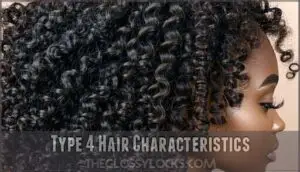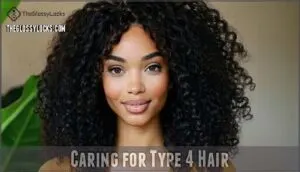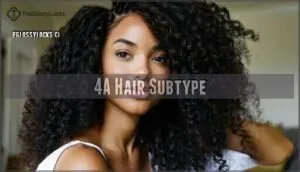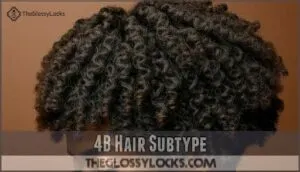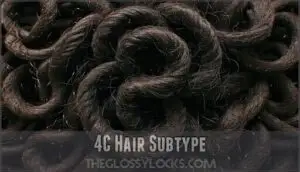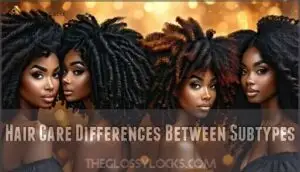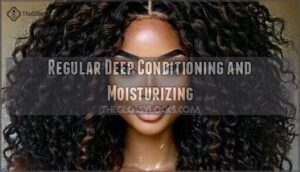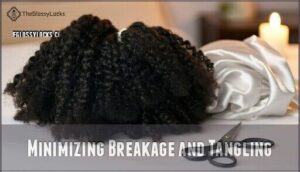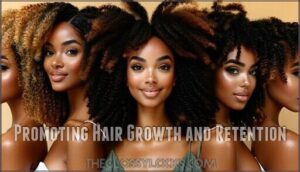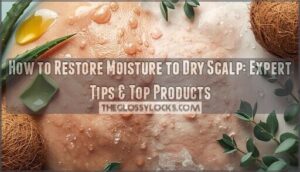This site is supported by our readers. We may earn a commission, at no cost to you, if you purchase through links.
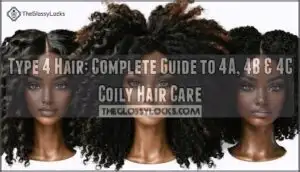 Type 4 hair represents the most tightly coiled texture on the hair spectrum, and it’s absolutely gorgeous when you know how to work with it.
Type 4 hair represents the most tightly coiled texture on the hair spectrum, and it’s absolutely gorgeous when you know how to work with it.
You’ll find three subtypes: 4A features soft, visible coils; 4B shows a zigzag pattern with less definition; and 4C has the tightest coils with minimal visible pattern.
Your hair’s spiral structure makes it harder for natural oils to travel down each strand, so moisture becomes your best friend, and it craves hydration, gentle handling, and protective styling.
Understanding your specific subtype reveals the secrets to achieving length retention and stunning definition.
Table Of Contents
- Key Takeaways
- Type 4 Hair Overview
- Type 4 Hair Characteristics
- Caring for Type 4 Hair
- Type 4 Hair Subtypes
- Maintaining Type 4 Hair Health
- Frequently Asked Questions (FAQs)
- What is a Type 4 hair?
- What ethnicity has type 4 hair?
- Can Mexicans have type 4 hair?
- How to identify if my hair is type 4c?
- How many types of alopecia are there?
- What are the 4 types of hair?
- Is there a type 5 hair?
- What is the rarest hair type?
- How Do Chemical Treatments Affect Type 4 Hair?
- Can Type 4 Hair Be Naturally Straightened?
- Conclusion
Key Takeaways
- Your type 4 hair has three distinct subtypes – 4A features soft, visible S-shaped coils; 4B shows zigzag patterns with a cotton-like texture; and 4C has the tightest coils with minimal definition and extreme shrinkage of up to 75%.
- Moisture is your hair’s lifeline – You will need to skip sulfate shampoos, use leave-in conditioners regularly, and deep condition weekly, since your coily structure makes it harder for natural oils to travel down each strand.
- Gentle handling prevents breakage – You should detangle only when wet, using wide-tooth combs, work from the ends upward, and sleep with satin bonnets or pillowcases to protect your fragile strands.
- Protective styling maximizes growth retention – You can use braids, twists, and Bantu knots to minimize daily manipulation, while maintaining scalp health and achieving length retention through consistent care routines.
Type 4 Hair Overview
Type 4 hair represents the most tightly coiled texture in hair classification systems, featuring distinct patterns that range from soft S-shaped coils to densely packed zigzag formations.
You’ll find this hair type mainly among people of African descent, and it requires specialized care techniques due to its unique structure and moisture retention challenges.
Andre Walker Hair Typing System
Back in the 1990s, celebrity stylist Andre Walker revolutionized hair classification by creating the most widely recognized hair typing system.
You’ll find his four-category framework—straight, wavy, curly, and coily—used everywhere today, and his system gave type 4 hair official recognition.
While system limitations exist regarding cultural impact and typing accuracy, Walker’s system remains the gold standard for understanding coily textures, despite system alternatives emerging.
LOIS Hair Typing System
While Andre Walker’s system uses numbers, the LOIS hair typing system takes a different approach.
This method eliminates hierarchical labeling that can stigmatize type 4 hair.
LOIS Breakdown uses letters representing strand patterns: L for bends, O for curls, I for straight, and S for waves.
It considers strand size and texture analysis alongside pattern recognition, offering thorough system comparison for kinky and coily hair without judgment, using a method that is free from hierarchical labeling.
NaturallyCurly Hair Typing System
NaturallyCurly’s system modifications take Andre Walker’s foundation and give it a fresh twist.
Their wavy focus, curly emphasis, and coily emphasis specifically spotlight type 4 hair textures that mainstream beauty often overlooks.
You’ll find their hair typing systems offer detailed product recommendations for 4A hair, 4B hair, and beyond.
NaturallyCurly champions your natural texture with targeted guidance.
Fia’s Hair Typing System
Building on previous hair typing systems, Fia’s method revolutionizes how you understand your type 4 hair texture.
This system integrates Andre Walker’s curl pattern classifications with LOIS incorporation for thorough analysis.
The system’s popularity stems from its detailed Andre comparison approach, making hair typing more precise than traditional methods alone, and it also includes Fia’s Volume Metric which measures strand thickness through a simple ponytail test.
Type 4 Hair Characteristics
Your type 4 hair features the tightest coils and kinks, making it unique among all hair textures.
You’ll notice that this hair type requires specific care approaches since it’s naturally drier and more fragile than straighter hair types, which can be described as naturally drier.
4A Hair Characteristics
Your 4A hair showcases beautiful S-shaped coils that feel soft and springy to the touch.
Your coils dance with natural bounce, celebrating the soft beauty that makes 4A hair truly magnificent.
This type 4 hair subtype offers better moisture retention than its kinky hair cousins, making it easier to maintain healthy strands.
Here’s what defines your coily hair texture:
- Curl Definition – Well-formed spirals with visible bounce
- Hair Softness – Naturally tender texture when properly moisturized
- Product Selection – Responds well to lightweight creams and oils
- Styling Versatility – Holds twist-outs and wash-and-go styles beautifully
4B Hair Characteristics
Moving from 4A’s softer coils, 4B hair displays a distinct Z-shaped pattern with cotton-like texture.
Your strands create zigzag formations rather than defined spirals, making them prone to breakage and significant shrinkage of 50% or more.
Despite these challenges, 4B hair offers incredible styling versatility.
This kinky, coily texture requires gentle handling but rewards you with stunning afrotextured styles that celebrate your natural beauty.
4C Hair Characteristics
At the pinnacle of coily hair textures, 4C hair showcases the tightest coils with extreme shrinkage that can hide your hair’s true length.
This afrotextured hair has low porosity, making product absorption challenging, and your kinky hair requires patience and specialized techniques to overcome styling challenges.
Despite these unique textures demanding extra care, 4C hair offers incredible versatility once you understand its needs.
Hair Texture and Porosity
Understanding the difference between texture vs. porosity helps you choose the right products for your type 4 hair.
Hair texture describes your coily hair’s curl pattern, while hair porosity measures how well your kinky hair absorbs moisture.
Identifying texture is visual, but porosity levels require testing.
Low porosity hair resists moisture, while high porosity hair absorbs it quickly.
Caring for Type 4 Hair
Type 4 hair requires a gentle approach that focuses on moisture retention and protecting your strands from damage.
You’ll need to adjust your routine to include sulfate-free products, regular conditioning treatments, and careful handling techniques that work with your hair’s natural texture, emphasizing protecting your strands.
Avoiding Sulfates and Heat Styling
Protecting your type 4 hair means ditching sulfate-heavy shampoos that strip natural oils.
Choose sulfatefree shampoo alternatives with gentle cleansing agents. Skip heat styling tools that cause hair breakage and hair damage.
Your natural textures shine brightest without blow dryers or flat irons. Embrace heatless styling methods instead.
Using a gentle shampoo alternative can help maintain moisture. Check product ingredients carefully for damage prevention.
Air-drying preserves your hair’s integrity and moisture.
Using Leave-in Conditioners and Moisturizers
After skipping harsh sulfates and heat tools, your type 4 hair craves deep hydration.
Leave-in conditioners become your best friend for moisture retention and frizz control.
Apply water-based products to damp kinky hair using proper application techniques.
Look for ingredients like shea butter and glycerin that penetrate coily hair effectively while promoting scalp health and maintaining your hair’s natural bounce.
Gentle Detangling and Handling
Your type 4 hair deserves tender handling to prevent breakage.
Wet detangling works best when you’re patient and gentle with your kinky hair texture.
Hair shedding is normal, but proper technique minimizes damage.
Essential detangling tools and techniques:
- Use wide-tooth combs or detangling brushes on soaked coily hair
- Section hair into manageable parts before starting
- Apply leave-in conditioner for slip during product selection process
These combs help with gentle hair management for proper technique and kinky hair texture, ensuring gentle handling.
Protective Styling and Hair Care Tips
Several protective styles can give your type 4 hair a much-needed break from daily manipulation.
Bantu knots, twists, and braids offer excellent style longevity while preventing product buildup.
Maintain scalp health by cleansing regularly between styles.
Establish a consistent night routine with satin bonnets or pillowcases.
DIY styles like twist-outs help retain hair moisture naturally, and using satin bonnets or pillowcases can aid in this process, while also promoting overall hair health.
Type 4 Hair Subtypes
Understanding the differences between 4A, 4B, and 4C hair helps you choose the right products and care routine for your specific curl pattern.
Each subtype has unique characteristics that affect how your hair responds to moisture, styling, and daily handling.
4A Hair Subtype
Your 4A hair boasts beautiful S-shaped coils that hold moisture better than other type 4 textures.
This curl pattern responds well to lightweight creams and gels for curl definition.
Focus on gentle detangling when wet and use protein treatments monthly for breakage prevention.
Your natural hair’s soft texture makes it perfect for twist-outs and wash-and-go styles with proper moisture retention techniques.
4B Hair Subtype
Moving beyond 4A’s defined curls, 4B hair presents unique styling challenges with its distinctive Z-shaped coils and cotton-like texture.
This subtype experiences high shrinkage and remains breakage prone without proper care.
Your 4B natural hair requires specific attention in these areas:
- Moisture retention – Combat dryness with regular deep conditioning
- Gentle handling – Minimize manipulation during styling routines
- Protective techniques – Use low-tension styles to prevent breakage
4C Hair Subtype
At the apex of curl intensity, 4C hair represents nature’s tightest coil pattern.
At the summit of natural texture, 4C hair showcases the most magnificent coils nature has crafted.
Your strands form dense Z-shaped spirals with minimal visible curl definition.
This subtype exhibits extreme shrinkage—up to 75%—and ultra-low porosity, making moisture penetration challenging.
| Characteristic | 4C Hair | Care Focus |
|---|---|---|
| Porosity | Ultra-low | Heavy creams, oils |
| Shrinkage | 75%+ | Stretching techniques |
| Styling | Protective focus | Twist-outs, braids |
Hair Care Differences Between Subtypes
Each subtype demands different approaches to tap into your hair’s potential.
4A hair thrives with lightweight oils for moisture retention, while 4B hair needs rich creams to combat breakage and shrinkage.
4C hair requires intense hydration due to low porosity barriers.
Product selection varies dramatically—what works for 4A might overwhelm 4C.
Styling variations reflect these differences, making personalized hair care essential for type 4 hair success.
Maintaining Type 4 Hair Health
You’ll need to establish a consistent routine that prioritizes deep conditioning and moisture retention to keep your type 4 hair healthy and strong.
Regular care prevents breakage, reduces tangling, and helps your coils maintain their natural definition while promoting steady growth.
Regular Deep Conditioning and Moisturizing
Deep conditioning becomes your type 4 hair’s best friend when done weekly. DIY Deep Conditioners using honey and avocado work wonders for hair hydration.
Apply moisturizing conditioner from mid-length to ends, focusing on the driest sections.
Protein Treatments should happen monthly to strengthen strands.
Effective hair care relies on hydration. Between washes, use Humectant Usage products and Oil Rinsing techniques for ideal hair moisturization and continuous Hydration Frequency maintenance.
Minimizing Breakage and Tangling
Breakage happens when your type 4 hair lacks proper hydration and gentle handling.
Start detangling on wet, conditioned hair using wide-tooth combs or fingers. Work from ends upward to prevent hair tangles.
Protective styles like braids reduce daily manipulation. Sleep with satin pillowcases or satin bonnets for satin protection.
Regular trimming every 8-12 weeks removes damaged ends, promoting healthier growth and better moisture retention.
Reducing Shrinkage and Enhancing Definition
After protecting your hair from breakage, you’ll want to tackle shrinkage and boost curl definition.
Type 4 hair’s natural tendency to contract can hide your true length, but strategic techniques help showcase your curls’ full potential.
Here are five game-changing methods for reducing hair shrinkage:
- Stretching Techniques – Keep hair organized in twists during wash day to prevent maximum contraction
- Curl Training – Use gels with strong hold to encourage elongating styles and maintain pattern
- Product Cocktails – Layer moisturizing creams before styling products for better hair elasticity
- Humidity Control – Air dry with diffusers to minimize environmental shrinkage factors
- Pineappling Method – Gather curls loosely at crown overnight for enhanced curl definition
Smart hair styling techniques make all the difference in managing your natural texture.
Promoting Hair Growth and Retention
Hair growth for type 4 hair starts with consistent hair care and scalp stimulation through gentle massage.
A healthy diet rich in vitamins supports your hair regimen from within.
Protective styles minimize manipulation while you trim regularly to prevent split ends.
Focus on reducing breakage through proper moisturizing and gentle handling to maximize hair health and retention.
Frequently Asked Questions (FAQs)
What is a Type 4 hair?
Like coiled springs waiting to bounce, Type 4 hair features the tightest curl patterns you’ll find.
It’s naturally dry and fragile, and shrinks substantially when wet, requiring gentle care and consistent moisture to thrive beautifully.
What ethnicity has type 4 hair?
You’ll find Type 4 hair mainly in people of African, Afro-Caribbean, and African-American descent.
This beautiful, tightly coiled texture represents your natural heritage and connects you to generations of stunning hair traditions, which is a part of your cultural background.
Can Mexicans have type 4 hair?
Yes, you can absolutely have type 4 hair if you’re Mexican.
Hair texture isn’t determined by nationality but by genetics.
Many Mexicans with African ancestry naturally have coily, kinky hair patterns characteristic of type
How to identify if my hair is type 4c?
Coincidentally, you’ve been wondering about your hair texture while staring in the mirror.
Look for tightly coiled strands with a Z-shaped pattern, minimal curl definition, and hair that shrinks dramatically when wet but feels densely packed.
How many types of alopecia are there?
You’ll encounter dozens of alopecia types, but doctors recognize six main categories: androgenetic, alopecia areata, telogen effluvium, anagen effluvium, traction alopecia, and cicatricial.
Each affects your hair differently, requiring specific treatments and care approaches.
What are the 4 types of hair?
Hair falls into four main categories: Type 1 is straight, Type 2 is wavy, Type 3 is curly, and Type 4 is coily or kinky.
You’ll find each type has distinct characteristics and care needs.
Is there a type 5 hair?
No established hair typing system recognizes a type 5 category. The Andre Walker system, which is most widely used, only classifies hair into four main types: straight, wavy, curly, and kinky.
What is the rarest hair type?
Like finding a rare gemstone in nature’s crown, you’ll discover that type 1A hair—perfectly straight, fine strands—stands as the rarest.
It’s naturally glossy but lacks volume, making it a unique treasure few possess.
How Do Chemical Treatments Affect Type 4 Hair?
Chemical treatments like relaxers, perms, and color can severely damage your fragile coils. They break down protein bonds, causing dryness, breakage, and weakened strands. You’ll need intensive moisture therapy afterward.
Can Type 4 Hair Be Naturally Straightened?
Breaking free from your coils isn’t impossible, but it’s like swimming upstream.
You can temporarily straighten type 4 hair using heat tools, blow-drying, or tension methods, but these won’t permanently alter your natural texture.
Conclusion
Mastering type 4 hair isn’t about fighting your natural texture—it’s about embracing what makes your coils unique.
You’ve learned the differences between 4A, 4B, and 4C subtypes, discovered essential care techniques, and understood why moisture matters most.
Your hair’s complex structure requires patience and the right approach, but the results speak for themselves.
With consistent deep conditioning, gentle handling, and protective styling, you’ll release your hair’s full potential and achieve the healthy, defined coils you’ve always wanted.

